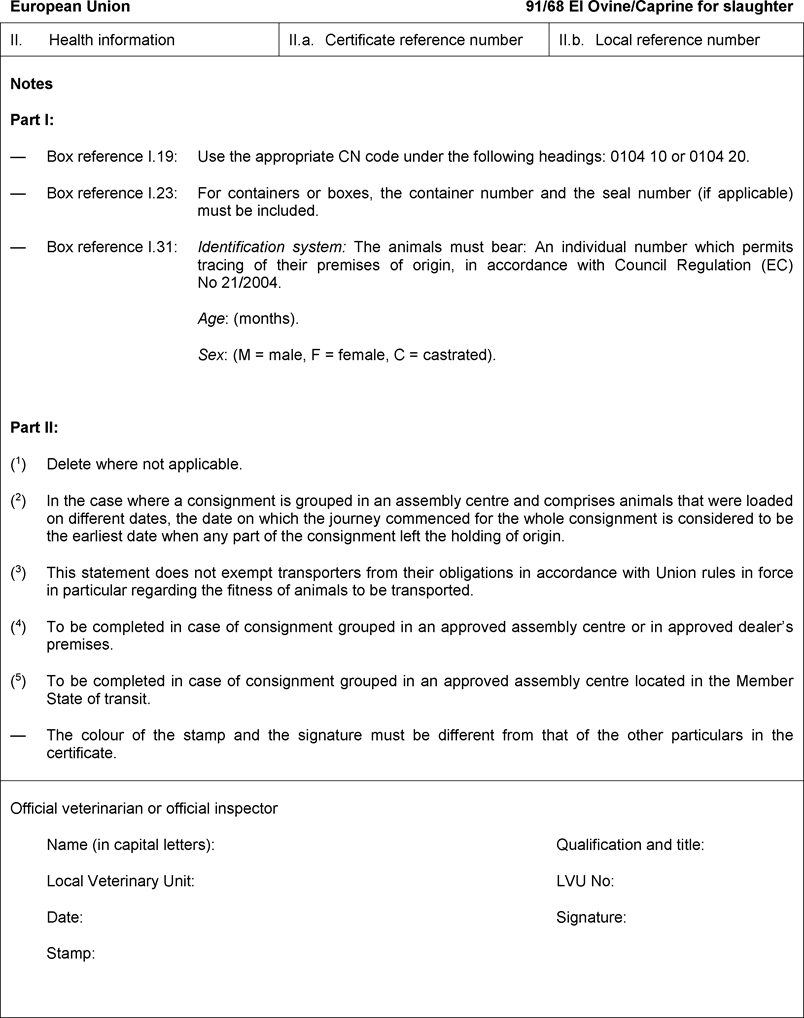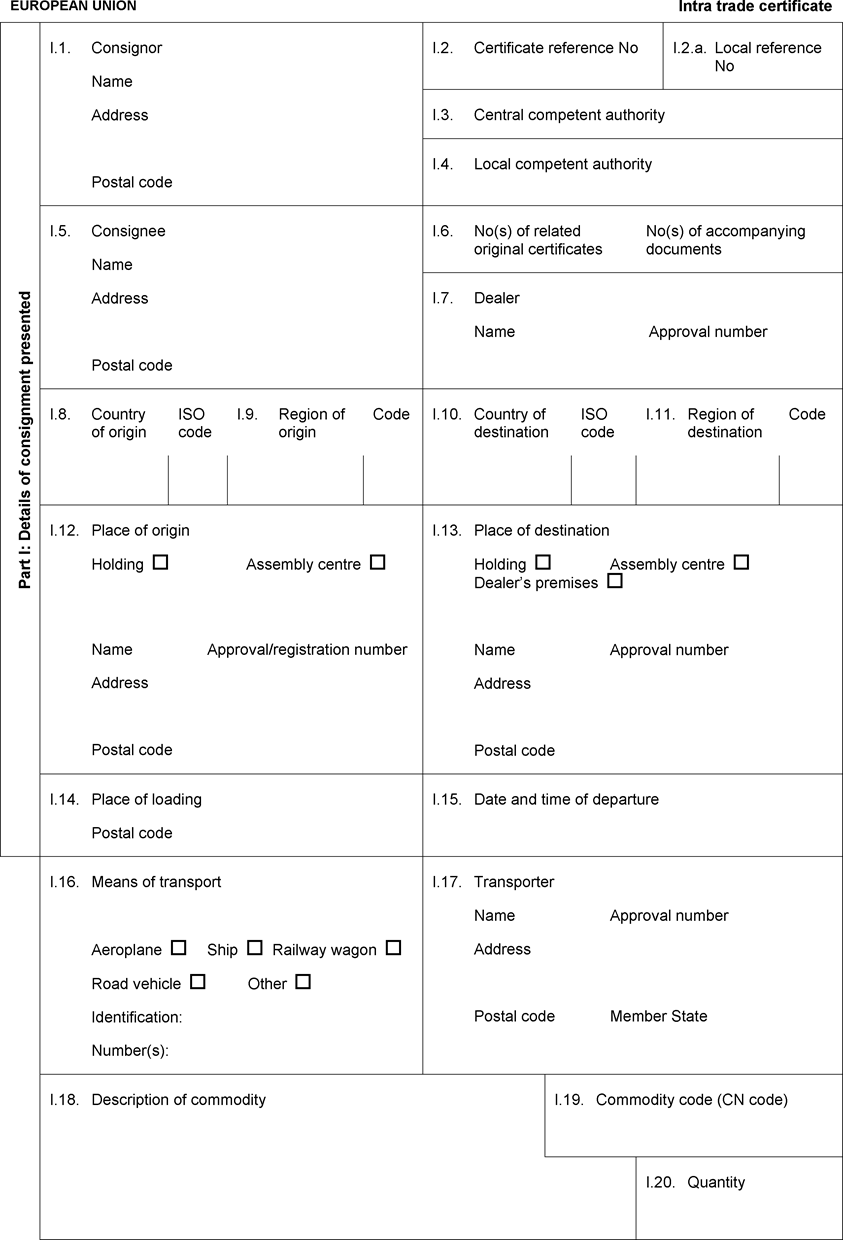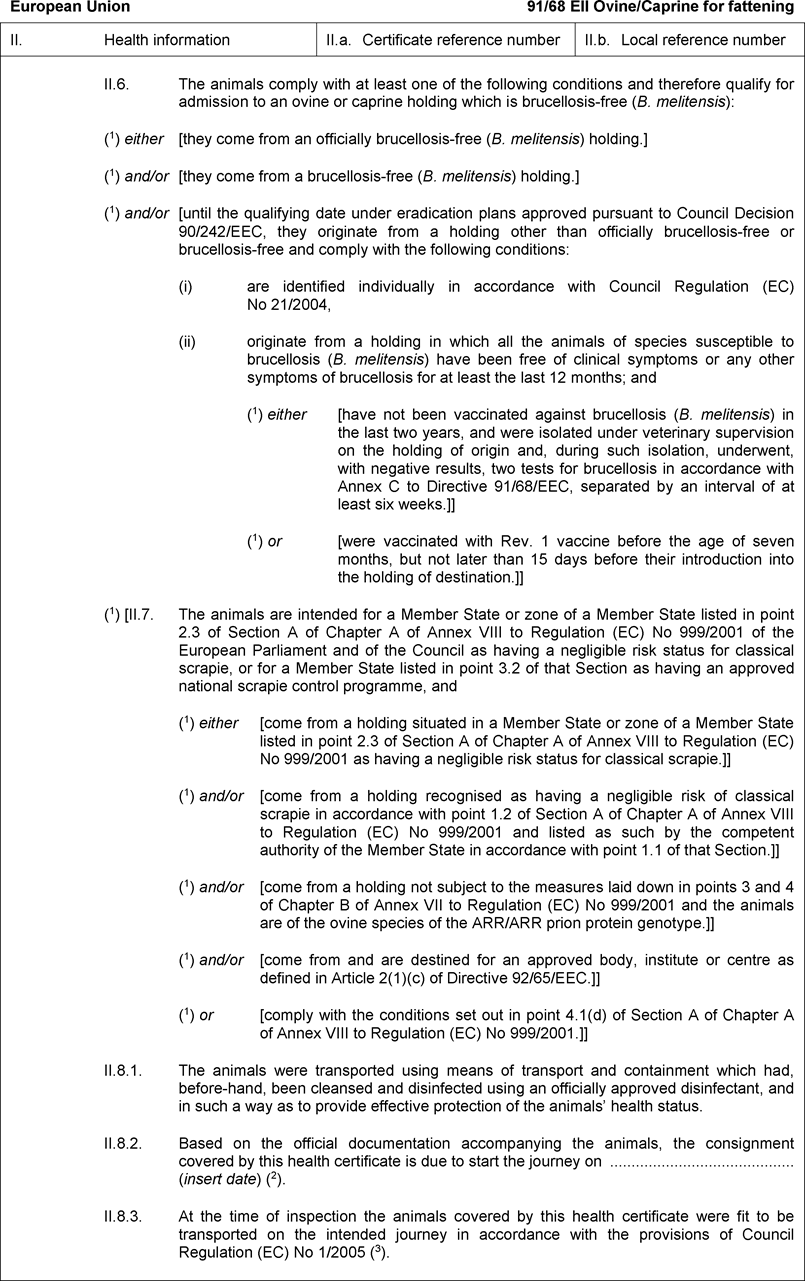
Print Options
PrintThe Whole
Directive
PrintThe
Annexes
only
Changes over time for: Council Directive of 28 January 1991 on animal health conditions governing intra-Community trade in ovine and caprine animals (91/68/EEC) (Annexes only)


Timeline of Changes
This timeline shows the different versions taken from EUR-Lex before exit day and during the implementation period as well as any subsequent versions created after the implementation period as a result of changes made by UK legislation.
The dates for the EU versions are taken from the document dates on EUR-Lex and may not always coincide with when the changes came into force for the document.
For any versions created after the implementation period as a result of changes made by UK legislation the date will coincide with the earliest date on which the change (e.g an insertion, a repeal or a substitution) that was applied came into force. For further information see our guide to revised legislation on Understanding Legislation.
Status:
EU Directives are published on this site to aid cross referencing from UK legislation. Since IP completion day (31 December 2020 11.00 p.m.) no amendments have been applied to this version.
ANNEX AU.K.
CHAPTER 1U.K.
I.Officially brucellosis (B. melitensis)-free ovine or caprine holdingU.K.
A.
Grant of status
An officially brucellosis (B. melitensis)-free ovine or caprine holding means
1.
a holding:
(a)
in which all the animals which are susceptible to brucellosis (B. melitensis) have been free from clinical or any other signs of brucellosis (B. melitensis) for at least 12 months;
(b)
which contains no ovine or caprine animals which have been vaccinated against brucellosis (B. melitensis), save those vaccinated at least two years previously with Rev. 1 vaccine or any other vaccine approved under the procedure laid down in Article 15 of this Directive;
(c)
in which two tests separated by an interval of six months or more have been carried out, with negative results, in accordance with Annex C on all ovine and caprine animals on the holding over six months of age at the time of testing; and
(d)
in which, following the tests referred to in point (c), there are only ovine or caprine animals born on the holding or which have come from an officially brucellosis-free or brucellosis-free holding under the conditions laid down in point D,
and in which, after qualification, the requirements laid down in point B continue to be fulfilled;
2.
a holding situated in an officially recognized brucellosis-free Member State or region in accordance with point II.
B.
Maintenance of status
1.
In the case of officially brucellosis (B. melitensis)-free ovine or caprine holdings which are not situated in a part of the territory which is recognized as officially brucellosis-free, and in which, after qualification, the introduction of animals is carried out in accordance with the requirements of point D, a representative number of the ovine and caprine animals over six months old must be checked annually. The holding may retain its officially brucellosis (B. melitensis)-free status if the results of the tests are negative.
The representative number of animals to be tested must, for each holding, consist of the following:
all non-castrated male animals over six months old,
all animals brought onto the holding since the previous test,
25 % of the females which have reached the age of reproduction (i.e. which are sexually mature) or are in milk, with a minimum of 50 per holding — except in holdings where there are fewer than 50 such females, in which case all females must be tested.
2.
For a region which is not officially brucellosis-free where more than 99 % of the ovine or caprine holdings are declared to be officially brucellosis (B. melitensis)-free, the frequency of checks of officially brucellosis-free ovine or caprine holdings may be extended to three years, provided that the holdings which are not officially brucellosis free are placed under official control or undergo an eradication programme.
C.
Suspected or actual cases of brucellosis
1.
Where, on an officially brucellosis-free ovine or caprine holding,
(a)
one or more ovine or caprine animals are suspected of having brucellosis (B. melitensis), the holding's officially brucellosis-free status must be withdrawn by the competent authority. However, that status may be provisionally suspended if the animal or animals are immediately destroyed or isolated, pending official confirmation of the disease or an official quashing of the suspicion of that disease;
(b)
brucellosis (B. melitensis) is confirmed, the provisional suspension may be lifted by the competent authority only if all animals infected or all the animals of species susceptible to infection are slaughtered and two tests, separated by an interval of at least three months or more, and carried out in accordance with Annex C on all the animals of the holding over six months old, give negative results.
2.
If the holding referred to in paragraph 1 is in a region which is recognized as officially free from brucellosis (B. melitensis), the Member State concerned must immediately inform the Commission and the other Member States.
The competent authority of the Member State concerned must:
(a)
slaughter all infected animals and all animals of species susceptible to infection on the holding concerned. The Member State concerned must keep the Commission and the other Member States informed of the development of the situation;
(b)
conduct an epidemiological enquiry, and the herds linked epidemiologically to the infected herd must undergo the tests laid down in point 1 (b).
3.
Should an outbreak of brucellosis be confirmed in accordance with point 2, the Commission after having assessed the circumstances of the renewed outbreak of brucellosis (B. melitensis) shall adopt, if that assessment so justifies, under the procedure laid down in Article 15, a decision suspending or withdrawing the status of that region. If the status is withdrawn, the conditions for a new qualification shall be specified in accordance with the same procedure.
D.
Introduction of animals onto an officially brucellosis (B. melitensis)-free ovine or caprine holding
Ovine or caprine animals may not be introduced into an ovine or caprine holding which is officially free from brucellosis unless they either:
2.
or:
come from a brucellosis-free holding and,
are identified individually in accordance with Article 4 (1) (a) of this Directive,
have never been vaccinated against brucellosis or if they have been vaccinated, were so vaccinated more than two years previously. However, females over two years old which were vaccinated before the age of seven months may also be brought onto the holding, and
were isolated under official supervision on the holding of origin and, during such isolation underwent, with negative results, two tests separated by an interval of at least six weeks in accordance with Annex C.
II.Officially brucellosis-free Member State or regionU.K.
Any Member State or region within the meaning of Article 2 (10) of this Directive may be recognized, under the procedure laid down in Article 15, as being officially brucellosis-free:
1.
(a)
in which at least 99,8 % of the ovine or caprine holdings are officially brucellosis-free holdings;
or
(b)
which fulfils the following conditions:
(i)
ovine or caprine brucellosis is a disease that has been compulsorily notifiable for at least five years;
(ii)
no case of ovine or caprine brucellosis has been officially confirmed for at least five years;
(iii)
vaccination has been prohibited for at least three years; and
(c)
for which compliance with these conditions has been established under the procedure set out in Article 15 of this Directive;
2.
in which the conditions set out in point 1 have been satisfied; and
(i)
[the first year following recognition of a Member State or region as brucellosis-free (Br. melitensis) , random checks carried out at either holding or slaughterhouse level show with a confidence rating of 99 % that less than 0,2 % of the holdings were infected, or at least 10 % of the ovine and caprine animals over six months of age have undergone a test carried out in accordance with Annex C with negative results;
annually, from the second year following recognition of a Member State or region as brucellosis-free (Br. melitensis) , random checks carried out at either holding or slaughterhouse level show with a confidence rating of 95 % that less than 0,2 % of the holdings were infected, or at least 5 % of the ovine and caprine animals over six months of age have undergone a test carried out in accordance with Annex C with negative results;
the provisions laid down in the above two indents may be amended in accordance with the procedure laid down in Article 15.]
(ii)
the conditions for qualification continue to be fulfilled.
CHAPTER 2U.K.Brucellosis (B. melitensis)-free ovine or caprine holding
A.
Grant of status
A. An ovine or caprine holding is considered to be brucellosis (B. melitensis)-free:
1.
in which:
(a)
all the animals susceptible to brucellosis (B. melitensis) have been free from clinical or other signs of brucellosis for at least 12 months;
(b)
all or some of the ovine or caprine animals have been vaccinated with Rev. 1 vaccine or any other vaccine approved under the procedure laid down in Article 15 of this Directive. The vaccinated animals must have been vaccinated before the age of seven months;
(c)
two tests separated by an interval of six months or more have been carried out, with negative results, in accordance with Annex C, on all vaccinated ovine and caprine animals on the holding which are over 18 months old at the time of testing;
(d)
two tests separated by an interval of six months or more have been carried out, with negative results, in accordance with Annex C, on all non-vaccinated ovine and caprine animals on the holding which are over six months old at the time of testing; and
(e)
after the tests referred to under points (c) or (d) have been carried out, all the ovine and caprine animals on the holding were either born there or come from a brucellosis-free holding under the conditions laid down in section D; and
2.
in which the requirements laid down under B continue to be fulfilled once it has qualified as brucellosis-free.
B.
Maintenance of status
An annual test must be carried out on a representative number of the ovine and caprine animals on each holding. The holding may retain its status only if the tests are negative.
The representative number of animals to be tested must, for each holding, consist of:
all non-castrated male animals over six months old which have not been vaccinated,
all non-castrated male animals over 18 months which have been vaccinated,
all animals brought onto the holding since the previous test,
25 % of females which are of reproductive age (sexually mature) or in milk, with a minimum of 50 per holding — except in holdings where there are fewer than 50 such females, in which case all these females must be tested.
C.
Suspected or actual cases of brucellosis
1.
The brucellosis-free status of an ovine or caprine holding must be withdrawn if the holding contains one or more ovine or caprine animals which are suspected of having brucellosis (B. melitensis). However, that status may be provisionally suspended if the animal or animals are immediately destroyed or isolated pending official confirmation of the disease or an official quashing of the suspicion of that disease.
2.
If brucellosis (B. melitensis) is confirmed, the provisional suspension may be lifted only if all animals infected or all the animals of the species susceptible to infection are slaughtered and two tests, separated by an interval of three months or more and carried out in accordance with Annex C on,
all vaccinated animals over 18 months old,
all non-vaccinated animals over six months old, and
both give negative results.
D.
Introduction of animals into a brucellosis (B. melitensis)-free ovine or caprine holding
The following animals only may be introduced into an ovine or caprine holding which is free from brucellosis:
1.
ovine or caprine animals which come from an ovine or caprine holding which is free from or officially free from brucellosis (B. melitensis);
2.
until the date laid down for holdings to qualify as brucellosis-free in accordance with the eradication plans adopted under Decision 90/242/EEC() ovine or caprine animals from holdings other than those referred to in point 1, provided that they meet the following conditions:
(a)
they must be individually identified in accordance with Article 4 (1) (a) of this Directive;
(b)
they must originate in a holding on which all animals belonging to species which are susceptible to brucellosis (B. melitensis) have shown no clinical or other signs of brucellosis (B. melitensis) for at least 12 months;
(c)
(i)
they must not have been vaccinated during the previous two years;
they must have been kept under isolation under veterinary supervision on the holding of origin and, during that period, must have undergone, with negative results, two tests separated by an interval of at least six weeks in accordance with Annex C; or
(ii)
they must have been vaccinated with Rev. 1 vaccine or any other vaccine approved in accordance with the procedure laid down in Article 15 of this Directive before the age of seven months and not less than 15 days before entering the holding of destination.
E.
Change of status
A brucellosis (B. melitensis)-free ovine or caprine holding may qualify as an officially brucellosis (B. melitensis)-free herd after a minimum period of two years if:
(a)
it contains no animal which has been vaccinated against brucellosis (B. melitensis) during the preceding two years at least;
(b)
the conditions laid down in point D.2. have been complied with throughout that period;
(c)
at the end of the second year, a test carried out, in accordance with Annex C, on all animals aged over six months has in each case given a negative result.
ANNEX BU.K.
I() U.K.
IIU.K.
. . . . . . . . . . . . . . . . . . . . . . . . . . . . . . . .
IIIU.K.
ANNEX CU.K.Brucellosis (B. melitensis) tests
For a holding to qualify for brucellosis-free status, testing for brucellosis (B. melitensis) is performed by means of the Rose Bengal method or by the complement-fixation method described in the Annex to Decision 90/242/EEC or by any other method recognized in accordance with the procedure laid down in Article 15 of this Directive. The complement-fixation method is used for tests on individual animals.
When carrying out the Rose Bengal test, if more than 5 % of the animals on a holding show a positive reaction, a further test is carried out on every animal on the holding by means of the complement-fixation method.
Serum containing 20 or more ICFT units/ml must be regarded as positive in the complement-fixation test.
The antigens used must be approved by the national laboratory and must be standardized against the second international standard anti-brucella abortus serum.
ANNEX DU.K.Official contagious epidydimitis (Brucella ovis) test
Complement-fixing test:
The specific antigen used must be approved by the national laboratory and must be standardized against the international standard anti-brucella ovis serum.
The working serum must be standardized with the international standard anti-brucella ovis serum prepared by the Central Veterinary Laboratory, Weybridge, Surrey, United Kingdom.
A serum containing 50 or more International Units per/ml must be regarded as positive.
[ANNEX E U.K.
MODEL I U.K.
MODEL II U.K.
MODEL III] U.K.

Back to top
















